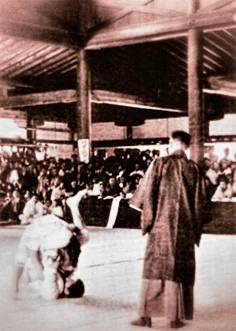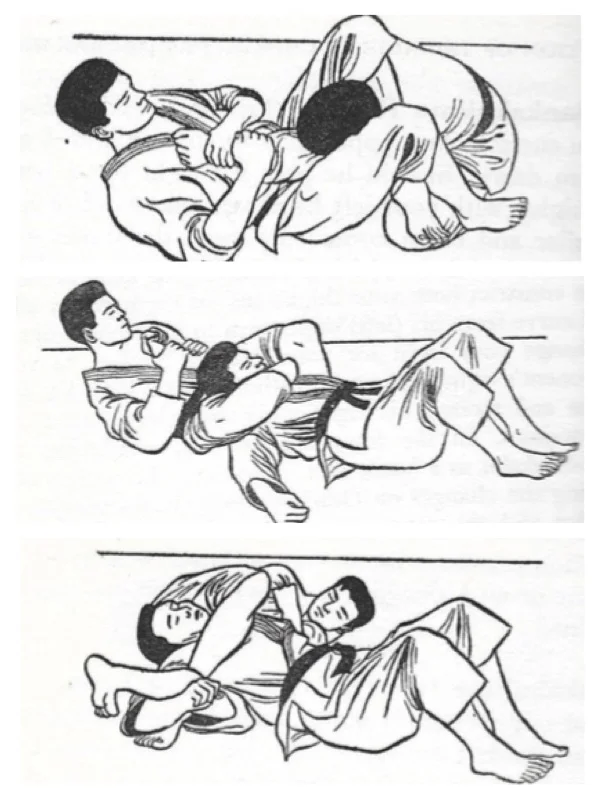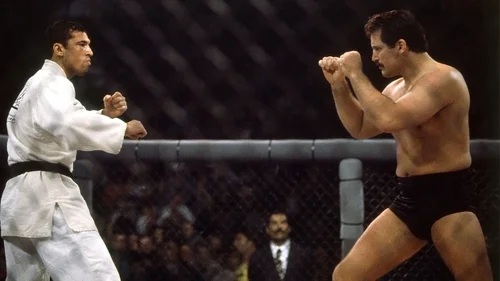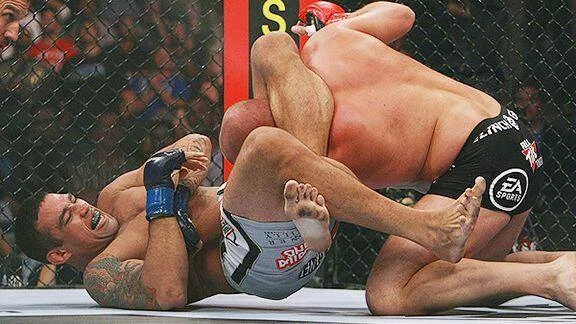By Julian G. Ortega | Valente Brothers Black Belt
Triangle being utilized in an old judo contest circa 1930’s
Many of the jiu-jitsu (jujutsu) techniques we commonly see in the dojos, training centers and fighting rings of the world have been little changed for centuries from the battlefield days of the samurai in feudal Japan. There exist four hundred year old books and scrolls with illustrations depicting men in old style kimonos and sometimes armor performing throws, armlocks and chokes on each other similarly to those which we apply to our own training partners on a weekly basis. Some techniques; however, have comparatively “modern” origins in jiu-jitsu’s long history and one of these is the triangle choke, or sankaku-jime as it is known in Japanese.
The triangle choke was developed in the earlier days of the Kodokan, sometime in the mid-1910s to early 1920s. There are two judo masters accredited with the development of the triangle choke; Join Oda (often referred to as Tsunetane Oda) and Kanemitsu Yachibei Hyoe. Oda is of particular note and there is a fairly well known video filmed in the 1950’s and available on YouTube of him performing techniques, many of which look much like “modern” Brazilian jiu-jitsu techniques, including a number of versions of the triangle choke from various positions.
Oda joined the Kodokan in 1910 and was awarded his first dan one year later in 1911. He, along with men like Hajime Isogai were instrumental in the development of what is now known as Kosen Judo. Kosen Judo is not a separate style, but a set of different competition rules that allowed more groundwork (Ne waza) than standard Kodokan rules. Kosen judo practitioners like Oda believed that the standup and ground techniques should be practiced 50/50, versus 80% standup and 20% ground espoused by judo’s founder Jigoro Kano.
A young Join Oda, one of the creators of the sankaku jime.
Kodokan competition rules had gradually changed many times over the years, every rule change eliminating some aspect of the jujutsu’s effective, but dangerous repertoire. Most significantly for ground grappling were the rule changes adopted by the Kodokan in 1925, which severely limited the way one could engage in ne waza as well as the amount of time allowed on the ground. Kano did not like the trend he saw towards more ne waza, which he felt was less aesthetically pleasing than the stand-up game and believed it went against his ideal of judo as a physical education versus pure fighting art. He did however recognize the merits of ground fighting and therefore allowed for ne waza “experts” and special rule events like those of the specialist high schools (where the Kosen judokas practiced and competed) to develop those skill sets. One of the most famous of those experts was Join Oda and it was in this environment where the triangle choke was developed.
Mitsuyo Maeda, who would later teach jiu-jitsu to Carlos Gracie, trained at the Kodokan from 1895 until 1904. In November 1904 he left Japan forever, accompanying Tsunejiro Tomita to the United States; kicking off a decade of globe-trotting, fighting and competing before he eventually landed on Brazilian shores. In Maeda’s time at the Kodokan there were no shortage of ne waza experts to train with. Men like Yokoyama, Isogai and Tanabe would have been a wealth of technical knowledge; however, in the year of his departure from the Kodokan, Oda and Yachibei were just kids who hadn’t yet started their martial training (the first specialist high school/Kosen judo competition was in 1914). It is clear that Maeda had to defeat all of his opponents without the use of the triangle choke, since he could not have known it.
It stands to reason then that the early days of the Gracie Academy in Rio de Janeiro, the triangle choke was not practiced. This was confirmed by Grandmaster Pedro Valente Sr. who started his training at the Academia Gracie in 1953, and noted that he never saw a triangle choke until the 1970’s. Some have accredited Rolls Gracie with re-discovering the triangle after seeing it in an old judo book and incorporating it into his famous open guard game. Another story is that one of the students from the Gracie Academy went to train in Japan and brought the triangle choking technique back with him. Regardless of which story is correct, there were some in Brazil who already knew the triangle choke prior to the 1970’s.
Several of the other well-known judo/jiu-jitsu practitioners, fighters and instructors in Brazil during the 1930’s and 1940’s include Geo Omori, Yasuichi Ono and Takeo Yano. Omori and Yano, both of whom Grandmaster Helio Gracie fought to draws in the 1930’s, graduated from the Kodokan in the 1920’s and therefore were exposed to the triangle choke. Japanese were notoriously secretive so they may or may not have passed these techniques down to their students in Brazil.
Yasuichi Ono working the triangle choke while preparing for his match with Helio Gracie. This was from a Brazilian newspaper dated December 5, 1935.
Once the triangle choke did find its’ way into the mainstream jiu-jitsu community in Brazil, its utilization began to grow. Although the sankaku jime can be applied from various positions; including from side mount, back mount, and the back-front (turtle) position; it is the triangle from the guard which applied best to the Brazilian style of agile and innovative guard work. When coupled with other guard techniques like armlocks, shoulder locks (omo plata) and sweeps, it slowly but surely became one of the most celebrated and devastating techniques within jiu-jitsu’s vast arsenal. This is why historically the triangle is the fourth most utilized submission in the UFC™ after the rear naked choke, guillotine choke and straight armlock (in 2015, it was only #5 behind the arm triangle²).
Three versions of the triangle choke. The figures are from the book “Judo on the Ground – The Oda Method”; by E.J. Harrison, published in 1959.
Perhaps the most famous triangle choke in MMA history was Royce Gracie’s submission win over Dan Severn in UFC 4 on March 11, 1994. Royce, weighing all of 178 pounds, spent most of the fifteen minute match on his back defending the relentless pressure of Severn’s 250 pounds of muscle; until the now legendary triangle was synched into place forcing Severn to tap. It was the first time most of the world had witnessed a triangle choke applied in a combat sport. Interestingly, many had unknowingly seen the triangle choke in action seven years prior, in the film “Lethal Weapon”, where Mel Gibson uses it to dispatch Gary Busey in the final scene of the movie. The scene was choreographed in part by Royce’s brother Master Rorion Gracie.
UFC 4, March 11, 1994, the first time most of the world witnessed a triangle choke applied in a combat sport.
In the years since Royce’s triangle victory, some of the most memorable submission wins in mixed martial arts have come as a result of triangle choke finishes in high profile fights; including Anderson Silva over Chael Sonnen and Fabricio Verdum versus Emelianenko Fedor. Noted ne-waza judo master Katsuhiko Kashiwazaki called the sankaku jime “one of the most successful shimewaza (chokes) in modern contest”. He also goes on to say “It is regarded as a special study in Japan – we feel it is the ultimate ne-waza technique. This is not only because of the latent power, but also because of its versatility.” Today, the triangle choke has become one of the most famous and fundamental techniques of jiu-jitsu, judo and mixed martial arts and its usage and applications continue to grow.
Fabricio Werdum finishes Emeilianenko Fedor in Strikeforce with a triangle choke June 26, 2010.
About the author:
Julian Ortega has been training martial arts for over 25 years and is a Valente Brothers Black Belt. He is the author of “Warrior Inspiration – Quotes and Maxims to Cultivate Mind, Character, and Fighting Spirit” and is an avid jiu-jitsu historian.
1 Sherdog Forum
2 Jiujitsu Times
3 Kashiwazaki, Katsuhiko, Shimewaza – Judo Masterclass Techniques, 1992







